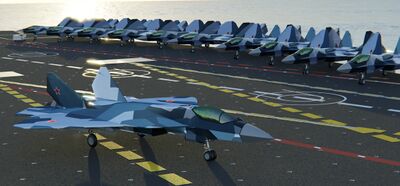K-40
| K-40 | |
|---|---|
 A number of navalized K-40 aircraft aboard a prototype Concordat carrier | |
| General information | |
| Type | Fighter |
| Status | Active |
| History | |
| Manufactured | 2014-Present |
| Introduction date | 2017 |
The K-40 Kestrel is the current Next Generation Fighter in use by most of the Concordat's Airforce, though the majority of early production aircraft are employed in the Kalaronian Airforce. Powered by two high-temperature OE-131 Turbofans, the Kestrel carries a larger weapon-payload than earlier stealthy designs produced by the Advanced Aeronautic Design Board of Velika Armaments. Designed to secure aerial supremacy in heavily reinforced airspace, the Kestrel has a secondary role in "cracking" that airspace open for less stealthy aircraft, aided by the introduction of the SVAM-13 "Small Volume Attack Missile" a year before it's adoption by Velika's home nation of Kalaron. The submission of the Kestrel officially elevated the corporation into the level of National Asset, with all the advantages that comes with it, including access to a number of prototypical engine designs to choose from for the following improvement project.
The OE-131 Turbofans powering the K-40 utilize a two-spool, low-bypass, mixed exhaust design, with exhaust temperatures of 1,700C at the Burner. Though there was an attempt to compensate for this high temperature with a Nickle-based Superalloy, the resulting engine has a lower than expected ratio of flight-hours per maintenance-hours. This, coupled with the increased weight of it's expected bomb-payload, lead to the Improved Fighter Project to develop a more advanced engine from the available experimental prototypes.
Additionally, the K-40 remains the most mass-produced of Velika's stealth designs. Of the several hundred airframes produced, Kalaron retained the first one hundred to furnish it's squadrons, with a further fifty held and devoted to the Joint Concordat Defense Militia as per the Member Obligations. It's versatile design, excellent thermal and radar stealth, and superb maneuverability have led to it seeing international customers, even beyond the official Concordat Members in small numbers.
Background
Prior to the collapse of the Trade Federation and it's restructuring as the Phoenix Concordat, the Kalaronian Armaments consortium maintained a sizeable monopoly on the production of high-cost Military Technology. Through the Trade Federation, Kalaron had secured protection from hostile forces, a large demand for it's weaponry, and vital alliances with local nations. However, the loss of the ITF, coupled with increasing hostility from the COMINTERN alliance on the matter of Sulanian Independence and the rising surge of nationalism in Africa, forced Kalaron to begin pursuing a new international Alliance of Nations from it's former compatriots in the ITF. This culminated in the development of the Phoenix Concordat, and with it, the need for a joint "Militia of Militaries" drawn from across the breadth of it's members, sufficient to defend a territory until reinforcements from the rest of the Alliance could arrive. To this end, development on the K-40 was authorized by the Kalaronian Airforce with the express intent that it become the primary Next Generation Fighter in the Concordat. Needing an aircraft with endurance, survivability, lethality and the ability to defend a large amount of area with a small number of proper jets, the Velika Aeronautics Corporation was eventually selected due to the low thermal signature of their demonstrated engine, and the feasibility of their design concept's magazine-based weapon's bay. With the contribution of Flight Commander Avatar annd his squadron of test pilots, Velika managed to quickly achieve both Scale Model testing and Version.05 flight construction underway.
Development
Though previous stealthy aircraft had been constructed for the Kalaronian Airforce by Kalaron Arms, doctrinal demands required that they be dedicated "Light-Interceptors", designed to chase down and interrupt opposing enemy aircraft within a very limited time-frame and location. This experience was of little aid in developing a heavier, larger and more enduring aircraft for use as both a strike-craft and a heavy aerial supremacy design. In fact, though the earlier OE-63 engines from those Interceptors was available for improvement, it was agreed by the Velika design team that the more advantageous engine to develop from instead came from the UR-107 "Vulture" regional bomber. Already designed for a moderately high-bypass, the TH-33 engines inside were used as the base for the OE-131 turbofans, modified for a greater overall pressure ratio and burner temperature. Further design aid came from the Kalaronian Arms Consortium, which provided access to their
Design
Operational history
Early service
Anti-bomber operations
Post-war service
Variants
The prototype flown in the 1939 fighter competition was designated Chikai WH 25, with WH indicating wŏnhyŏng (prototype). Six were built. Its armament consisted of four 7.5mm machine guns: two above the nose, and one in each wing. Each gun was fed from a 500-round belt.
Type 40-I
Type 40-II
Type 40-III
Type 40-IV
Type 40-V
Specifications (Type 40-I)
General Characteristics
- Crew:
- Length:
- Wingspan:
- Height:
- Wing Area:
- Empty Weight:
- Loaded Weight:
- Powerplant:
Performance
- Maximum Speed:
- Range:
- Service Ceiling:
- Rate of Climb:
- Wing Loading:
- Power-to-Mass ratio:
Armament
- Guns:
- 2x forward-firing
- 2x forward-firing
- Bombs: